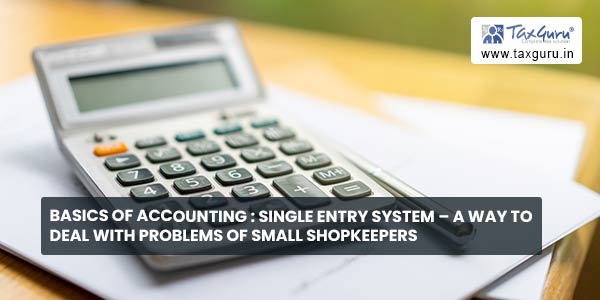Basics of Accounting : Single Entry System – A way to deal with problems of small shopkeepers
Single Entry System may consist (Types of Single Entry Books) :
a. Double entry in respect of certain transactions e.g. Debtors and Creditors (Personal Accounts only) etc and single entry for all remaining transactions.,
b. Double Entry in respect of almost all transactions and Single entry in respect of certain transactions e.g Single entry for cash book transactions only.
c. No entry for certain transactions and Single or Double entry for all other transactions.
“Single Entry System is a system of book keeping in which as a rule only record of cash and personal accounts are maintained. Volume of Incomplete Double Entry varies with the circumstances.”
In our day to day life when we deals with accounts specially of small shopkeepers we may encounter any of the above situations. It’s upto an experienced/qualified Accountant or CA how he make incomplete records complete & how he transform books maintained on single entry basis to double entry. Knowledge of Single Entry System is useful to an accountant right from accounting, ITR filing to representation in search and survey proceedings.
Features of Single Entry System (Generally maintained by Small Shopkeepers) :
a. Maintenance of transactions related with personal accounts on double entry basis and maintenance of transactions related with real and nominal accounts on single entry basis.
b. Maintenance of Cash Book with mixed transactions. Normally both personal and business transactions are mixed in cash book,
c. Completion of records depends on availability of Original Vouchers like Insurance Premium Receipts, Purchase Invoices of Assets, Invoices of Sales and Purchases of goods etc.
d. Form and Accounting Accuracy of Single Entry system differ from firm to firm.
e. Incomplete Records (Single Entry System) is suitable (Can be suggested) to Small businesses/ Proprietary Concerns/ Partnership Firms.
Fundamental Equations which are basis of Incomplete Records:
I. Assets – Liability = Equity
and
II. Income = Savings + Expenditures
We all know that both these equations are widely used in Income Tax Search cases where whole of the pleading on behalf of assessee is pleaded on the satisfaction of these accounting equations. It has to be emphasized here that these equations are equally useful during the accounting & book keeping and similarly at the time of ITR filing and assessment proceedings other than raid cases.
Net Worth Method : Under net worth method Profit/Loss is deduced from Networth or in other words Capital of two different dates. Example :
| Rs. Figures in ‘000 | |||
| Date | Assets | Liabilities | Equity |
| 01.04.2021 | 500000 | 300000 | 200000 |
| 31.03.2022 | 700000 | 150000 | 550000 |
Profit earned during the period is : Equity as on 31.03.2022 – Equity as on 01.04.2021
Or 550000 – 200000 = 350000
Adjustments in Profit Figures :
A. Adjustment for Drawings : Under Net worth method drawing has to be added back in the profit figure arrived as above.
B. Adjustment for Capital Introduced :– For profit calculation capital introduced has to be reduced from the profit derived as above.
Statement of Affairs Vs Balance Sheet :
Statement of Affairs is simply a list of Assets and Liabilities which is not balanced which is prepared from Incomplete Accounting Information. On the contrary Balance Sheet is complete information of Assets & Liabilities prepared on double entry system basis and which is balanced.
A. Balance Sheet is prepared from Trial Balance and Statement of Affairs is prepared directly from cash book, Ledger and other additional information.
B. Balance Sheet is assumed as true and Statement is not so assumed.
C. Omissions from Balance Sheet are difficult to trace and omissions from Statement of Affairs are difficult to trace.
How statement of affairs can be prepared in Single entry system of book keeping :
I. Cash Book may provide certain Information Like information as to a. Cash and Bank Balances, b. Purchases/Sale of Assets, c. Payment/incurrence of Liabilities and d. Capital Introduction and Withdrawals.
II. Information out of Vouchers :- Assets and stock etc. purchased or sold. Details of Investments can be derived from account statements.
III. Debtors/ Creditors Ledgers :- As normally personal accounts are maintained on double entry basis their list can be prepared from Ledgers. I
V. Stock value is derived from physical verification.
V. Outstanding and Accrued : Information of Outstanding and Accrued is obtained from Previous year figures.

Partnership Firms : i. Balances in capital A/c of all the partners taken on collective basis for profit figure. ii. Under Fixed Capital System profit figures are arrived from variable capitals of the partners on collective basis.
Methods of Accounting in Single Entry System of Book Keeping :
I. Conversion Method : Under this method Single Entry Accounts are converted into Double Entry Accounts. After preparation of Statement of Affairs following exercise is performed :-
A. Figures of Sales and Purchases are derived from total Debtors and Creditors Accounts maintained (Entries made from Personal Ledgers).
B. Figures of Expenditure and Incomes are deduced from Receipt and Payment (Cash Book) and other Additional Information.
C. After completing entries on both sides (Dr. and Cr.) Trial Balance can be prepared.
D. Any other Information which was not expected by the accountant may arise on preparation of trial balance.
II. Abridged Conversion Method : No efforts are made to transform Single Entry into Double Entry. Accounts are not opened in the Ledger nor trial is prepared. Only Information necessary to prepare Trading and P & L is collected.





